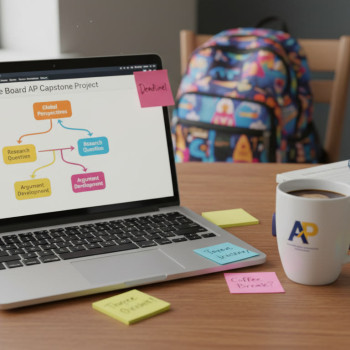Research Methods: Quant, Qual, Mixed—Which Fits Your AP Project?
Why this matters for AP students
If you’re standing at the start of an AP Research project, an AP Statistics investigation, or a class assignment that suddenly feels like a thesis, congratulations: you’re about to learn the language of evidence. Choosing the right research method—quantitative, qualitative, or mixed—can be the difference between an unfocused paper and a compelling study that earns top marks and, more importantly, teaches you how to think like a scholar.

Quick definitions (so we’re on the same page)
Before diving into strategy, here are short, student-friendly definitions.
- Quantitative methods — involve numbers, measurements, and statistics. Think surveys with scaled responses, experiments, and anything you can calculate or graph.
- Qualitative methods — involve words, observations, and meaning. Think interviews, focus groups, participant observation, and thematic analysis.
- Mixed methods — combine both: you might survey a large sample to find patterns (quant) then interview a few participants to understand why those patterns exist (qual).
Which method fits which kind of AP project?
AP Research and AP Statistics both reward clear reasoning and rigor. But the subject, your research question, and practical constraints play the starring roles when you decide method.
When Quantitative is the right call
Choose quantitative methods when your question is about magnitude, frequency, correlation, differences between groups, or prediction. Example prompts where quant shines:
- How does sleep duration relate to math test scores among high school juniors?
- Does a three-week study-app intervention increase vocabulary test performance?
- What percentage of students prefer digital notes to handwritten notes, and do preferences differ by grade?
Quant benefits include clear, replicable procedures and the ability to generalize—if your sample is representative. For AP projects, that clarity helps your reader (and your evaluator) follow your logic from hypothesis to conclusion.
When Qualitative is the right call
Choose qualitative methods when you want depth, nuance, and context. Qual explores lived experiences, motivations, processes, and complex meanings. Good qualitative questions include:
- How do first-generation college students describe their experience navigating AP courses?
- What are teachers’ evolving perspectives on remote instruction after two years of hybrid learning?
Qualitative work allows for rich quotes, narrative structure, and thematic insight. It’s especially powerful when the phenomenon is not easily reduced to numbers—or when you want to generate hypotheses rather than test them.
When Mixed Methods gives you the best of both worlds
Mixed methods are ideal when a question needs both breadth and depth. For example:
- Use a survey to identify patterns in student study habits (quant), then interview a subset to explore the reasoning behind those habits (qual).
- Run a small randomized classroom intervention (quant) and follow with teacher focus groups to unpack the classroom dynamics that numbers alone can’t explain (qual).
Mixed designs often produce more convincing arguments because they allow cross-validation: the numbers show trends; the words show meaning.
Practical checklist: Choosing your approach
Here’s a quick decision checklist to help you decide—great for brainstorming or an early project meeting with your teacher or mentor.
- What is your core question? If it asks “how many” or “how much,” lean quant. If it asks “how” or “why,” lean qual.
- What resources and time do you have? Surveys and experiments can be fast but require careful sampling; interviews take time for recruitment, transcription, and analysis.
- How many participants can you access? Small, deep samples favor qual; larger samples make quantitative claims more credible.
- Is generalizability important? If you need to generalize to a wider population, prioritize rigorous quant design and sampling.
- Do you need both numbers and stories? If yes, design a mixed methods study and be intentional about integration (more below).
Short table: Matching question types to method strengths
| Question Type | Best Method | Why |
|---|---|---|
| How common is X? | Quantitative | Allows measurement of prevalence and statistical description. |
| Why do people do X? | Qualitative | Captures motivations, context, and meaning through rich data. |
| Does intervention Y cause change? | Quantitative (experimental) or Mixed | Experiments can test causality; qualitative adds process insight. |
| How do patterns and experiences relate? | Mixed Methods | Combines broad patterns with in-depth explanations. |
Design essentials for each method
Key design steps for quantitative studies
Quantitative design looks neat on paper, but good practice matters. Follow these essentials:
- Start with a clear hypothesis or research question: e.g., “Students who study in 25-minute blocks will score higher on retention tests than students who study in 50-minute blocks.”
- Define variables: Independent, dependent, control variables—be explicit about how you measure each.
- Sampling: Who are you studying? Random samples are ideal but not always possible; explain limitations.
- Data collection tools: Surveys should use validated scales when possible; experiments should include random assignment or clear controls.
- Analysis plan: Decide which statistics (t-test, ANOVA, correlation, regression) you’ll run before collecting data, and justify them.
Key design steps for qualitative studies
Qualitative design centers on depth and trustworthiness:
- Craft open-ended research questions: Ask “How do students describe…” or “What is the experience of…”
- Sampling: Purposeful sampling helps you find participants with the experiences you want to understand.
- Data collection: Conduct interviews, focus groups, or observations with thoughtful prompts and good rapport.
- Ethics and consent: Be explicit about recording, anonymity, and consent—this matters for AP projects too.
- Analysis: Use coding, theme development, and memoing. Keep quotes to show evidence for themes.
Design pointers for mixed methods
Mixed designs require planning for how and when the methods interact:
- Sequential explanatory: Collect quantitative data first, then qualitative to explain results.
- Sequential exploratory: Start qualitative to inform a quantitative instrument or hypothesis.
- Concurrent: Collect both types at once and integrate during analysis.
- Integration: Be explicit about how the qualitative and quantitative findings connect. Integration can occur through joint displays (tables showing numbers and themes together) or a narrative that weaves both results.
AP-focused tips: How to show methodological rigor to your reader
AP readers value clarity and defensibility. Use these writing strategies to make your method section stand out.
- Explain choices, don’t assume they’re obvious: If you used convenience sampling, say why and discuss limitations.
- Be transparent about instruments: If you created a survey, provide the scale items in an appendix and report reliability (Cronbach’s alpha) if possible.
- Report participant details: Age range, grade level, recruitment method, and sample size help readers evaluate generalizability.
- Triangulate evidence: In mixed or qual designs, show how different data sources corroborate each other.
- Use visuals: Tables, charts, and simple models can summarize design and findings clearly (use a table to show your sample breakdown or an experimental timeline).
Example: How to write a concise methods paragraph
“We surveyed 182 tenth- and eleventh-grade students across two public high schools using a 12-item study-habits questionnaire (α = 0.82). Participants were recruited through classroom announcements and provided informed consent. To explore motivations behind study choices, we conducted semi-structured interviews with a purposeful subsample of 12 students selected for variability in GPA and reported study time. Quantitative data were analyzed using Pearson correlation and linear regression; interview transcripts were coded inductively for emergent themes. Results from both strands were integrated to provide a comprehensive picture of study behaviors.”
Analysis and presentation: turning data into an argument
Numbers, themes, and quotes become persuasive when tied to a clear narrative. Think of analysis as storytelling with evidence.
For quantitative results
- Start with descriptive statistics: means, medians, standard deviations, and clear visuals.
- Report inferential statistics with effect sizes and confidence intervals—not just p-values.
- Use tables to present key results compactly; reserve narrative for interpretation, not repetition of every number.
For qualitative results
- Organize around themes—each theme gets its own section with illustrative quotes.
- Discuss deviant or contradictory cases; complexity earns evaluation points.
- Explain how you moved from raw data to themes (coding process, interrater checks if used).
For mixed-methods results
Integration is the centerpiece. Use joint displays—tables or matrices that show numbers beside themes—to let readers see how evidence from different strands reinforces one another.
Common pitfalls and how to avoid them
Avoid these frequent mistakes AP students make, and your project will gain credibility and polish.
- Vague research questions: Make your question specific and researchable.
- Poor sampling logic: Explain why your sample is appropriate and what limits generalization.
- Overclaiming: Don’t generalize beyond what your data support. If your sample is local, say so.
- Ignoring ethics: Even small student projects need clear consent and privacy steps.
- Under-analyzing qualitative data: Quotes alone aren’t analysis—tie quotes to themes and interpretation.
Tools and practical resources for AP students
You don’t need expensive software to do solid research. Here are accessible tools and how you might use them in an AP context:
- Spreadsheets (Google Sheets, Excel) — Descriptive stats, basic graphs, and tidy data storage.
- Free survey platforms (Google Forms) — Collect quantitative responses quickly; export to Sheets for analysis.
- Audio-recording apps — Record interviews, then transcribe using a simple text editor or low-cost services.
- Qualitative coding templates — Start with color-coding transcripts in a document before moving to software.
How tutoring can help (a natural fit)
Working with a tutor can be a huge advantage when planning and executing research. Personalized tutoring—like Sparkl’s 1-on-1 guidance—can help you build tailored study plans, refine your research question, design appropriate methods, and interpret data with confidence. Expert tutors can review drafts, suggest analyses, and explain complex concepts in plain language, while AI-driven insights can surface patterns you might miss on your own.
Realistic timeline for a semester-long AP Research project
Here’s a practical timeline you can adapt depending on your school’s calendar. It assumes roughly 12–16 weeks of active work.
| Weeks | Milestone | Deliverable |
|---|---|---|
| 1–2 | Topic selection and question refinement | Research question and brief literature notes |
| 3–4 | Method selection and protocol development | Method section draft, instruments (survey/interview guide) |
| 5–8 | Data collection | Raw data: survey responses, transcripts, observations |
| 9–11 | Data analysis | Statistical results, coded transcripts, theme matrix |
| 12–14 | Write-up and integration | Full draft, tables, and figures |
| 15–16 | Revision and final submission | Final paper and presentation materials |
Examples to learn from (mini case studies)
Seeing how a study is crafted can help you envision your own. Here are three short, AP-friendly examples you could adapt.
Case 1: A Quant Study on Note-Taking
Question: Do students who take Cornell-format notes score higher on subsequent quizzes than students who take linear notes?
Design: Randomly assign two class sections to note formats, give a 3-week unit, then run identical quizzes. Analyze mean differences with t-tests. Report effect size and classroom implications.
Case 2: A Qual Study on Classroom Climate
Question: How do students perceive the role of peer feedback in classroom learning?
Design: Conduct semi-structured interviews with 15 students representing diverse performance levels. Use thematic coding to identify emergent themes (trust, usefulness, anxiety). Use quotes to support themes and discuss implications for instructional practice.
Case 3: Mixed Methods on Homework Habits
Question: What study strategies predict higher AP exam readiness, and how do students describe using those strategies?
Design: Survey 250 students about study habits and perceived readiness (quant). Then interview 20 students across high, medium, and low readiness to understand habits in context. Integrate findings to recommend targeted interventions.
Final advice: Write with clarity, defend with evidence
Your research project is part detective work, part storytelling. A strong methods section doesn’t just list steps—it explains why those steps were the best way to answer your question. Use clear language, show your work, and acknowledge limitations. That intellectual honesty is exactly what AP scorers look for.

A note on support
If you ever feel stuck, consider getting targeted help: one-on-one mentorship can guide your question refinement, suggest methods that match your resources, and help you interpret results. Sparkl’s personalized tutoring is designed to support students with tailored study plans, expert tutors, and AI-driven insights—useful when you want feedback on drafts or help choosing the right analysis path.
Parting encouragement
Whether you gravitate toward numbers, stories, or a mix of both, this is your chance to practice disciplined curiosity. The best projects don’t merely collect data—they ask smart questions, use appropriate methods, and tell honest, evidence-based stories. Take your time, plan clearly, and let your curiosity lead the way. You’ve got this.
Ready to brainstorm questions, design a method, or draft a methods section? Start small, iterate, and reach out for feedback—your next great project is one thoughtful decision at a time.


















No Comments
Leave a comment Cancel